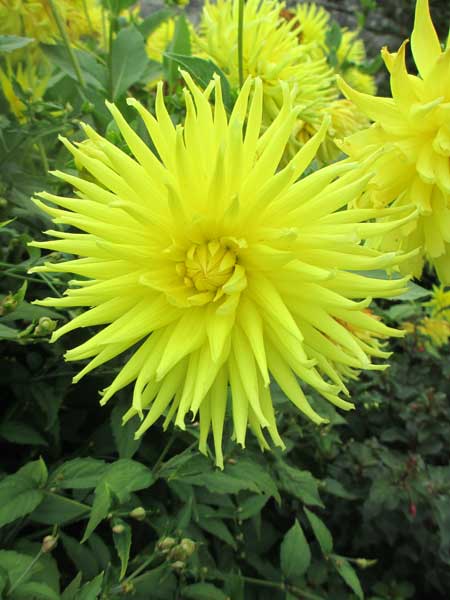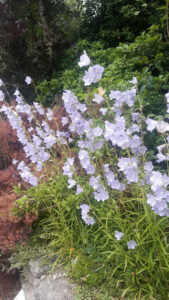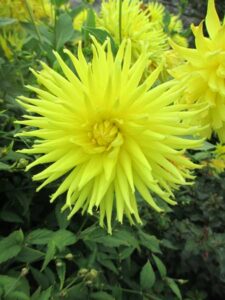DELIGHTFUL DAHLIAS
I have come to the conclusion that the more you get to know the subject, gardening becomes infinitely more puzzling! The more you get to know plants, the more you realise how differently they behave in certain circumstances, and, as years go by, you see how they vary according to the weather and their own whimsey. Some plants you never understand at all. Take dahlias for example.
Dahlias really are a gift but they fell from fashion two decades ago and it is only now that they are undergoing something of a revival. They’re easy to grow and need minimal care. In recent years I have grown these interspersed with other bold, large-leaved, strong-coloured foliage plants, shrubs included. All they need in autumn is lifting and storing in damp peat in a frost-free shed or garage with just an occasional inspection now and again up to late March. Then, they’re moved into separate pots and stood in good light in the greenhouse until all signs of frost have gone. Planted out in May, they can then be left on their own until they need staking so they won’t flop about in windy weather. And if all that is too much for you, but pot-grown specimens this month of May from garden outlets.
Ensure that all your dahlias have cane supports or similar. This really is important. And if you prefer large, single blooms on your plants ‘disbud’ any competing flower buds by snapping off those located at either side of the central, largest bud. Keep feeding with tomato food once flowering commences. This is essential for dahlias to have the ability and the stamina to go on flowering without interruption until the first really hard frosts. In the far south and in all coastal counties this can be as late as the second week in December.
So for minimal input you get a miraculous output, one tuber giving you 400 to 500 flowers in a constant stream from early July until the end of November. ‘Moonfire’, which I have covered in the past, remains one of my favourite decorative forms, having attractive leaves of purple and black and single flowers with a pleasant apricot-yellow and a central ring of red. It does extremely well in a pot (which can then be taken for a stroll around before deciding where it is to be finally placed) and if you dead-head regularly, it blooms non-stop into December. Another super variety is Procyon (I found this in a Glanmire supermarket) and now it takes pride of place in the back garden from June to November.
You may not realise it but dead-heading of all varieties pays handsome dividends. Many gardens can easily slide into premature decay as early as the opening days of August (due to prolonged heat and drought) and regular dead-heading is essential in order to prevent much of this. For certain plants, such as the non-repeat flowering roses, the aim is purely cosmetic. But many plants, especially dahlias (also cosmos, penstemons and late flowering salvias) can be induced to flower indefinitely if none of their blooms is allowed to set seed.
There are rare instances of dead-heading where it is acceptable simply to snap off spent flowers with finger and thumb and this is certainly the case with daylilies. But in general, secateurs or a stout pair of scissors will be needed for dahlias. It is essential with these to trace the stem of a spent flower back to some definite point, as any bare stalks you leave behind will disfigure the whole plant. This point will be where a new shoot or a fresh flower arises or is likely to arise. Done diligently and with care, your dahlias will excite and please you up to the very beginning of winter. All varieties may be planted out now in their flowering positions. However, if the foliage appears above ground before the final frosts, then protect with some form of covering on cold nights.
IN THE GARDEN MAY 2023
How can anyone ignore the changing seasons, the arrival of spring with its brand new light highlighting the buds on trees and blossom covered branches? The tide of spring (late as it is) is quite unstoppable, and it sweeps us into action, ready or not! These first quiet spring notes are the beginning of a crescendo that will peak in the blast of trumpets from Regale lilies in July. Before then however, there are preparations to be made.
Weeds and long grasses growing under hedges are often overlooked but they need pulling out. Left undisturbed they will rob the soil of moisture and nutrients to the detriment of the hedge itself. If you work carefully, these growths can be quickly and easily killed with ‘Weedol’ even when conditions are cold and miserable. A damp sponge wetted with a solution of Weedol gently brushed over offending weeds will cause them to die in under two days (add a squirt of washing-up liquid to increase its stickiness). The chemical won’t kill the likes of dandelion and dock but all the softer kinds, grasses too, will certainly succumb. Naturally, you will have to avoid getting the weed-killer onto the hedge itself or on any green growths on nearby ornamental plants.
Conditions, as I write, are ideal for moving plants and shrubs, for dividing perennials and for applying lawn food and moss-killer. If moving shrubs try not to break the root-ball as you lift the plant and do have the new hole dug and ready in advance. Don’t neglect watering for the first six weeks following the move. Perennial plant divisions are also more likely to succeed if, having lifted the clump, you carefully slice off as many pieces as you want with a sharp knife. Outer sections will be found the most reliable, for the inner, central portions usually grow hard, woody, and unproductive.
A good chemical control of lily beetle and r weevil is still available.. Called ‘Bug Clear Ultra’ it is specifically for eliminating mostr garden pests. The product will also kill scale insects. Now what are these you may ask? Well, if your camellias, for instance, suffer ‘black leaves’ they’re most likely to be suffering an attack from scale insects.








